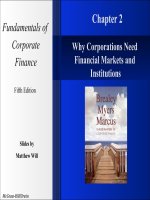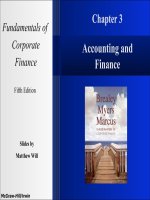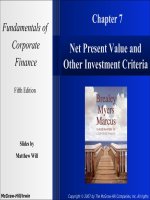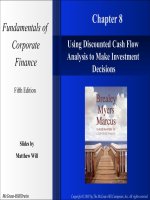Fundamentals of corporate finance 10e ROSS JORDAN chap012
Bạn đang xem bản rút gọn của tài liệu. Xem và tải ngay bản đầy đủ của tài liệu tại đây (1.19 MB, 56 trang )
Chapter 12
Some Lessons from Capital Market History
12-1
McGraw-Hill/Irwin
Copyright © 2013 by The McGraw-Hill Companies, Inc. All rights reserved.
Chapter Outline
•
•
•
•
•
•
12-2
Returns
The Historical Return
Average Returns: The 1
st
Lesson
The Variability of Returns: The 2
More about Average Returns
Capital Market Efficiency
nd
Lesson
Chapter Outline
•
•
•
•
•
•
12-3
Returns
The Historical Return
Average Returns: The 1
st
Lesson
The Variability of Returns: The 2
More about Average Returns
Capital Market Efficiency
nd
Lesson
Risk, Return and
Financial Markets
Looking back through time we know…..
1.There is a reward for bearing risk
2.The > the risk = the > the potential return!
12-4
This is called: The Risk/Return
Trade-of
12-5
Dollar Returns
Total dollar return =
income from investment
+ capital gain (or loss) due to the
change in price
12-6
What is my return?
12-7
•
You bought a bond for $950 one year ago.
•
You have received two coupons of $30 each.
•
You can sell the bond for $975 today.
•
What is your total dollar return?
What is my return?
•
Income = 30 + 30 = 60
•
Capital Gain =
975 - 950 = 25
•
Total Dollar return =
60 + 25 = $85
12-8
Percentage Returns
It is generally more intuitive to
think in terms of percentage,
(rather than dollar), returns
12-9
Percentage Returns
1.
Dividend Yield = income/beginning
price
2.
Capital Gains Yield = (ending price – beginning price) /
beginning price
3.
Total percentage return = dividend yield + capital gains
yield
12-10
Percentage Returns
•
You bought a stock for $35.
•
You received dividends of
$1.25.
•
The stock is now selling for
$40.
12-11
Percentage Returns
1.
Dividend Yield = income/beginning
price
1.25 / 35 = 3.57%
2.
Capital Gains Yield = (ending price – beginning price) / beginning
price
(40 – 35) / 35 = 14.29%
3.
Total percentage return = dividend yield + capital gains yield
3.57 + 14.29 = 17.86%
12-12
The Importance of
Financial Markets
Financial markets allow companies, governments and
individuals to increase their utility/wealth
Savers have the ability to invest in financial assets so that they
can defer consumption and earn a return to compensate them for
doing so
Borrowers have better access to the capital that is available so
that they can invest in productive assets
12-13
The Importance of
Financial Markets
Financial markets also provide
us with information about the
returns that are required for
various levels of risk
12-14
Chapter Outline
•
•
•
•
•
•
12-15
Returns
The Historical Return
Average Returns: The 1
st
Lesson
The Variability of Returns: The 2
More about Average Returns
Capital Market Efficiency
nd
Lesson
12-16
Year-to-Year Total Returns
Large-Company
Stock Returns
Large Companies
Long-Term Government
Bond Returns
U.S. Treasury Bill Returns
12-17
Long-Term Government Bonds
U.S. Treasury Bills
Chapter Outline
•
•
•
•
•
•
12-18
Returns
The Historical Return
Average Returns: The 1
st
Lesson
The Variability of Returns: The 2
More about Average Returns
Capital Market Efficiency
nd
Lesson
A Comparison of
Average Returns
Investment
12-19
Average Return
Large Stocks
12.3%
Small Stocks
17.1%
Long-term Corporate Bonds
6.2%
Long-term Government Bonds
5.8%
U.S. Treasury Bills
3.8%
Inflation
3.1%
Now let’s add risk to the picture
12-20
Risk Premiums
•
The “extra” return earned for taking on risk
•
Treasury bills are considered to be risk-free
•
The risk premium is the return over and above the
risk-free rate
12-21
Average Annual Returns and Risk
Premiums
Investment
12-22
Average Return
Risk Premium
Large Stocks
12.3%
8.5%
Small Stocks
17.1%
13.3%
Long-term Corporate Bonds
6.2%
2.4%
Long-term Government Bonds
5.8%
2.0%
U.S. Treasury Bills
3.8%
0.0%
Chapter Outline
•
•
•
•
•
•
12-23
Returns
The Historical Return
Average Returns: The 1
st
Lesson
The Variability of Returns: The 2
More about Average Returns
Capital Market Efficiency
nd
Lesson
12-24
Variance and Standard Deviation
12-25









